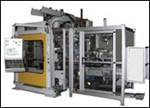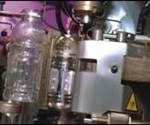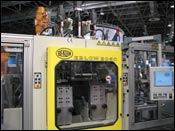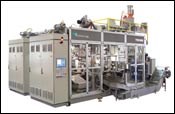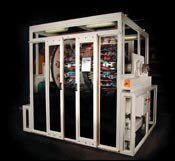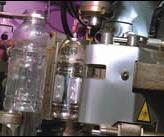K 2007 Blow Molding: Electric Machines Take Hold
Development of all-electric and hybrid-electric blow molding machines may be gaining momentum, as evidenced by several new models introduced in Dusseldorf.
Development of all-electric and hybrid-electric blow molding machines may be gaining momentum, as evidenced by several new models introduced in Dusseldorf. Energy-saving electric drives appeared on new machines for extrusion blow, stretch-blow, and injection-blow processes. There was also no lack of conventionally powered machines boasting higher speed, greater output, and faster mold changes.
Other innovations included a new “Mini Wheel” extrusion blow molder to replace multi-parison shuttles, novel lightweighting options for PET containers, and a new material-distribution monitoring system for PET bottles that claims to take lightweighting to a new level. A number of other machine launches at the show were previewed in September (see Learn More).
ELECTRIC EXTRUSION BLOW
Bekum went all-electric at the show with its new EBlow 206 D, a 6-ton press said to offer energy savings up to 25%. The four-cavity machine claims many of the same benefits of other electrics, including low maintenance, cleanliness, and quietness. Bekum also touts a novel linear-actuated clamping system (not a toggle) whose electric drive applies force to regulate speed and pressure at final closing.
At the show, Bekum produced 200-ml HDPE bottles in a 5.5-sec cycle, or 2610 bottles/hr. The double-station unit is aimed initially at medical/pharmaceutical cleanroom uses. Larger machines up to 20 tons are being considered.
Meanwhile, Techne’s Advance series with clamp force up to 20 tons is claimed to offer the highest cavitation of any all-electric shuttle today. The modular Advance 510 and 700 models carry one to four molds. Techne claims energy savings of 35% and cycle-time savings of 10% to 25% vs. hydraulics. Bottle weight is held within ±0.1%, according to Techne. The firm is looking to make larger all-electrics with a 700-mm mold stroke. These would have a maximum of 10 parisons and 40 cavities.
The all-electric Mini Wheel extrusion blow molder from Graham Engineering (which uses hydraulics only for parison programming) is said to be a breakthrough for smaller processors looking to dramatically increase throughput. “Rotary wheel technology is now available to mid-sized blow molders who did not have the quantities to justify the purchase of a wheel machine in the past,” says Dave Yenor, v.p. for global business development. Targeted applications include coextruded containers for dairy and “organic” drinks, nutraceuticals, and probiotics.
The 12-station unit is said to be more economical and less complex than a multi-parison, double-sided shuttle. It is also more energy efficient. Lightweight molds (20 to 25 lb) can be handled without a lifting hoist, and changeover time is competitive with shuttles. Coextrusion configurations with up to six layers are available.
A servo-driven mold closing system is featured on a new hybrid continuous-extrusion shuttle machine from Italy’s Automa (represented in the U.S. now by Scherer Plastics Systems). The Apex AT 950MT is a single-station machine equipped with a double carriage. The lightweight twin mold carriage is built of titanium alloy and is said to allow faster cycles, smooth movement, and lower energy consumption. The carriage slides on linear ball-bearing guides, powered by a hydraulic cylinder controlled by a proportional valve. An improved mold-cooling system reportedly results in less mildew and rust on the tools. At the show, the machine produced 28-g HDPE containers in a 13-sec cycle.
As reported in September, Uniloy Milacron also showed off a new hybrid shuttle, the UMS 16H.S, which reportedly uses 22% less energy than an all-hydraulic shuttle.
ELECTRIC STRETCH-BLOW
The trend to all-electrics is also growing in stretch-blow, as Nissei ASB Co. claimed to introduce the industry’s first all-electric, one-step injection stretch-blow system. The small four-station model ASB-15N/10E was launched as a prototype at NPE 2006 in Chicago. Energy use is reduced by 60% compared with Nissei’s similar hydraulic machine. The new press has a compact footprint of 3 x 8 ft and is targeted for lower production volumes. Despite its small size, the unit’s 15-ton clamp can handle wide-mouth jars. At the show, it ran 100-ml PP pill bottles in four cavities with a 10-sec cycle, or 1440 bottles/hr.
Urola USA has expanded its all-electric reheat stretch-blow line with a new model to produce containers up to 10 liters. The URBI 2L linear reheat machine has two cavities and is aimed at water, juices, and edible oils. The first machine has been sold to a Los Angeles blow molder for production of edible oil bottles up to 5L. At the show, the machine made 5L bottles in a 3-sec cycle at 2400/hr. Urola also plans to launch a four-cavity unit.
Italy’s Siapi S.r.l. has come out with the second generation of its all-electric linear reheat line. The EA7 has seven cavities for bottles up to 2L while the EA8 has eight cavities for containers up to 1.5L. Improvements include preferential heating for oval or rectangular containers and an air-recovery system that reduces compressed-air use by 30%. Output of 12,000 bottles/hr for water, carbonated soft drinks (CSD), and edible oil is about 8% higher than previous models.
ELECTRIC INJECTION-BLOW
Said to be the largest all-electric injection-blow machine yet, the 100-ton UMIB 100 was showed off by Uniloy Milacron. It reportedly uses 40% to 60% less energy than the same size hydraulic press. Its patented upper platen has three tiebars instead of four, and two molds are mounted on one platen. The result is said to be shorter dry-cycle time and no synchronization issues between the injection and blow stations.
Another new all-electric injection-blow offering is the Unimax 50 FE from Germany’s MBM Maschinenbau Muhldorf GmbH. The 50-ton, four-station machine is available with eight to 16 cavities and has a shot pot for more precise process control. Cycle time is 10 to 12 sec for 4- to 250-ml containers. Markets include high-end cosmetics, personal-care products, and pharmaceuticals.
In addition, Germany’s Novapax has expanded its hybrid injection-blow line with a 120-ton model. The NSB 1200/250-840 ES has an electric screw drive that reduces energy use by 10%. At the show, the machine ran 12 cavities and made 80-ml PET containers in a 12-sec cycle.
ULTRALIGHT PET BOTTLES
Lightweighting of PET containers was a central theme at the show, as machine suppliers showed off new ways to slim down 500-ml water bottles. Sidel’s 9.9-g NoBottle utilizes so-called flex technology, which provides flexibility and shape memory so that bottles spring back to their original shape when deformed—all without incorporating ribs. Flex technology made its commercial debut with Nestle Waters bottles made on Sidel stretch-blow machines.
Italy’s SIPA has developed a 0.5L bottle for still and carbonated water weighing 10.9 g. It is suitable for carbonated drinks because of the petaloid base. It also withstands palletizing and can be stretch-blown on any SIPA machine. Caps and labels already used by the bottler need not be changed.
Not to be outdone, Krones showcased an 8.8-g water bottle claimed to be the industry’s lightest 0.5L container. It is 28% to 45% lighter than typical PET water bottles. The weight of the mouthpiece was reduced from 3.5 g to 1.96 g and the neck ring was essentially eliminated. The bottle’s wall thickness was cut down 20% to 30% to 0.1 mm. Still, the ultralight bottle has a reported topload strength of 33 kg. It meets commercial requirements and Krones has already booked an order for a system to produce a similar 0.6L bottle.
A new measurement system from Agr TopWave facilitates lightweighting of PET containers by monitoring material distribution in real time. The PETWall Profiler measures thickness distribution over the entire sidewall, using 32 sensors on a typical 2L bottle and registering 1000 measurements per sensor. AGR’s previous PETWall Plus system had only four sensors. With the new unit, it is reportedly possible to precisely identify very small changes in material distribution.
At the heart of the system is a digital signal processor that captures and interprets thickness data at 52,000 samples per sec for each measurement sensor. This processing speed permits monitoring bottles at blow molding speeds exceeding 100,000 bottles/hr. The monitoring system is available in a stand-alone version or can be integrated into new and existing blow molders. Versions are available for the most common rotary stretch-blow systems from Krones, SIG Corpoplast, Sidel, and SIPA. An OEM version can be factory installed and is available through some machine suppliers. The cost depends on the number of sensors, ranging from $70,000 to $110,000. Agr TopWave is running customer trials and expects to ship its first system in the second quarter.
In other PET molding developments, Swiss-based Mag-Plastic Machinery expanded its low-cavitation product range by acquiring the rights to build larger linear stretch-blow molders designed by Alkam in Italy. Mag-Plastic now offers six models with four to 10 cavities for standard water and CSD bottles and one to two cavities for larger containers up to 26.5L. Mag-Plastic also acquired production rights for a unique double-cavity machine to produce 25L containers at 600/hr.
A new compact PET preform injection molding machine from Nissei ASB Co. has a rotary vertical clamp and a narrow cavity pitch that doubles the capacity of current machines. The PM-70/65N clamp unit speeds opening and closing of the injection mold, and the narrow pitch minimizes the mold space and permits two rows of eight cavities. The unit also has a built-in preform cooling device. At the show, the machine produced 14-g preforms in 16 cavities at 6000/hr. Nissei may adapt this design to larger machines.
Krones unveiled a new modular oven for its Contiform reheat stretch-blow machines. The linear oven has spindles that are belt- instead of chain-driven and a 40-mm pitch for increased stability and reliability. A new ergonomic design provides improved accessibility for operation and maintenance. By using convection heat, the oven is also said to be more efficient. It eliminates exhaust fans and uses a “chimney effect” to remove heat. A first-quarter roll-out is planned.
OPP SHOWS PROMISE
Oriented PP containers have been talked about for years, but a new partnership may bring them closer to commercial reality. As reported last month, Kortec Inc., a leading supplier of turnkey coinjection systems, has been licensed to develop and sell Ball Corp.’s Gamma-Clear OPP technology outside North America (see Learn More). The three-layer (PP/EVOH/PP) barrier containers are made using modified reheat stretch-blow molding machines from Sidel and others while the preforms are coinjected on equipment from Husky.
The development is based partly on new material technology in the form of a maleic anhydride additive that is added to the PP to eliminate delamination from the EVOH, which was previously a major obstacle to such multilayer structures. Gamma-Clear OPP wide-mouth containers can be hot-filled at up to 200 F and are targeted for oxygen-sensitive foods.
Kortec expects to supply high-output systems with up to 48 cavities for 26-oz wide-mouth containers. Wide-neck finishes range from 63 mm to 70 mm for tomato sauce. Systems for up to 144 cavities can be produced for narrow-neck (28 to 40 mm) containers.
EXTRUSION BLOW NEWS
Graham announced a partnership with Thailand’s Sabmann Blasformtechnik to market and service a new shuttle machine called the SBG 700 D. Sabmann will make the clamp and frame assembly and Graham will supply the extruder and process controls.
The new shuttle is designed for easy interchange of molds with Graham’s HLD 700 shuttle and other makes of shuttles. The SBG 700 D offers greater daylight and clamp force (25 tons) than the HLD 700, permitting production of larger containers. It is also fast, with a 3.6-sec dry cycle. For small bottles, the clamp opening stroke can be minimized using the proportional hydraulic control.
Bottles are transported to the rear of the clamp directly from the trim station using a two-axis, servo-driven pick-and-place system. This provides single-point, oriented bottle takeout while using a minimum of floor space and enabling easy access to the clamp from front and side. The new machine has horizontal mold movement but utilizes rails with linear bearings instead of tiebars to support the clamp carriage.
Automa also launched a new hydraulic shuttle machine for large containers up to 30L. The Apex AT 700 DJC is a compact double-station unit with 33 tons of clamp force. Robotic takeout with vacuum cups and a merge conveyor bring containers to one side of the machine. The machine runs two molds, producing 30L chemical containers in a 32-sec cycle.
Plastimac of Italy (represented here by American Jet Stream) announced that its hybrid continuous-extrusion shuttle machine for large jerry cans now includes an adjustable die ring to optimize radial wall-thickness distribution. Model PB30/S has a static deformable die ring that controls the circumferential thickness distribution throughout the entire parison length. At the show, the machine produced 20L HMWPE jerry cans at 80/hr.
Germany’s Rikutec, a supplier of accumulator-head machines for large drums and containers up to 10,000 liters and coextrusion with as many as seven layers, has acquired the rights to make and sell a flexible die-ring system for selectively adjusting wall thickness to optimize part weight. Invented by Dr. Heinz Gross of Darmstadt, Germany, the mechanism is a layered, flexible metal die ring with several hydraulic or electric “pushers” or cylinders that apply external pressure on the ring. The number of pushers depends on the part’s complexity.
This flexible die ring is claimed to be more versatile than typical PWDS systems that are limited by fixed movements. Rikutec says blow molders can achieve better thickness distribution resulting in weight savings and faster cycles. Rikutec is incorporating the technology across its line of machines and is also offering it to other machine makers.
Bottle surfaces can now acquire a unique gradation color effect with new extrusion head technology from Germany’s W. Muller GmbH. Molded-in color can fade from dark to light in both two and three-layer configurations. Specific details were not revealed, but W. Muller says the technique involves running the main layer consistently while the second layer is started and stopped in a controlled sequence. The head can be adapted to any shuttle machine. Two heads have been sold to a U.S. customer for personal-care bottles and three have been sold to a German molder for shampoo containers.
Related Content
Breaking News From NPE2024
Here is a firsthand report of news in injection molding, extrusion, blow molding and recycling not previously covered.
Read MoreNew Bottle Base for Nitrogen-Dosed Products in 100% rPET
Sidel’s new StarLITE-R Nitro offers an alternative to petaloid bases with equal performance in a wide range of 100% rPET bottle sizes.
Read MoreEnd-to-End Quality Management For Aseptic PET Beverage Bottling
Sidel introduces Qual-IS comprehensive quality system to merge all QC activities in PET aseptic beverage bottling, from the preform blowing to laboratory management.
Read MoreFor Extrusion and Injection-Blow Molders, Numerous Upgrades in Machines and Services
Uniloy is revising its machinery lines across the board and strengthening after-sales services in tooling maintenance, spare parts and tech service.
Read MoreRead Next
What's New at the Show in BLOW MOLDING
There will be a strong emphasis on energy savings in blow molding machinery at K 2007.
Read MoreHot-Fill Packaging: OPP and 'Panel-Less' PET Bottles Grab the Spotlight
Improved clarity and cost competitiveness, added to its inherent heat resistance, are reviving OPP’s prospects in hot-fill barrier containers. But hot-fill PET containers are raising the bar with higher productivity and ‘panel-less’ bottle designs.
Read MoreBeyond Prototypes: 8 Ways the Plastics Industry Is Using 3D Printing
Plastics processors are finding applications for 3D printing around the plant and across the supply chain. Here are 8 examples to look for at NPE2024.
Read More
